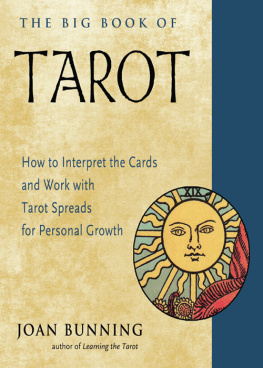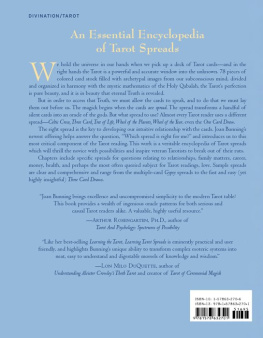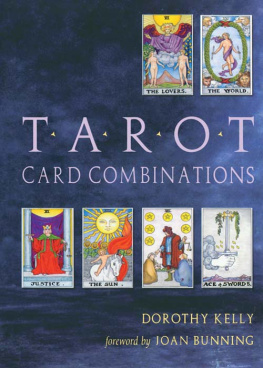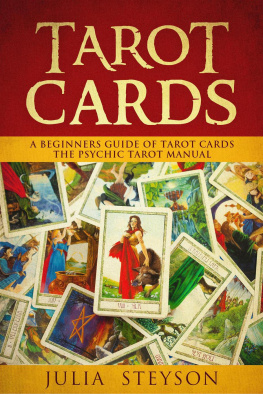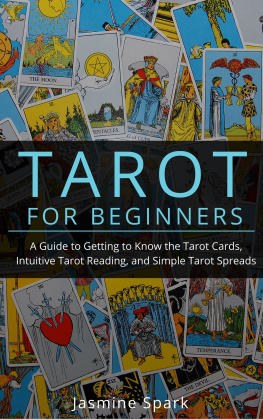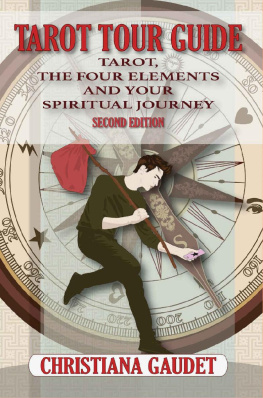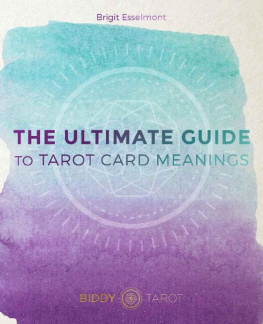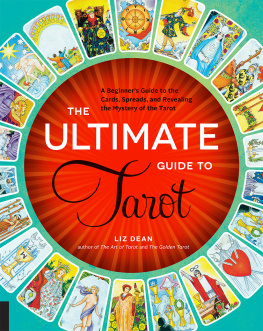

This edition first published in 2019 by Weiser Books, an imprint of
Red Wheel/Weiser, LLC
With offices at:
65 Parker Street, Suite 7
Newburyport, MA 01950
www.redwheelweiser.com
Copyright 2019 by Joan Bunning
All rights reserved. No part of this publication may be reproduced or transmitted in any form or by any means, electronic or mechanical, including photocopying, recording, or by any information storage and retrieval system, without permission in writing from Red Wheel/Weiser, LLC.
Reviewers may quote brief passages.
This edition is a collection of portions of these previously published titles: Learning the Tarot
(1998), Learning Tarot Reversals (2003), and Learning Tarot Spreads (2007)
published by Weiser Books.
Tarot card images derived from the Waite deck created by Red Wheel/Weiser, LLC.
ISBN: 978-1-57863-668-6
Library of Congress Cataloging-in-Publication Data available upon request.
Cover and text design by Kathryn Sky-Peck
Printed in the United States of America
TS
10 9 8 7 6 5 4 3 2 1
www.redwheelweiser.com/newsletter
CONTENTS
PREFACE
I discovered the tarot at a time in my life when I was seeking and exploring. I was open to whatever might help me understand my inner experiences. It was in that spirit, when by chance I sat next to a psychic at a conference. We got to talking, and he eventually gave me an intuitive reading. The first words he said to me were You should study the tarot. I had heard about the cards, but knew very little about them. My inner guidance suggested I heed his advice, so I did.
I bought some books, a deck of tarot cards, and began to practice and take notes. I immersed myself as I tend to do. One day, a rough, but fully-formed chapter about the court cards appeared in my mind. What is this? I thought. I was puzzled, but intrigued, so I wrote down what I was receiving. One thing led to another, more chapters followed, and eventually I had written a book. I tried to get it published, but with no success, so I put the manuscript away.
Some years later, I developed a course and created a website for it, www.learntarot.com. My goal was simply to share what I had written while pursuing what seemed like a fun project. I began receiving feedback the very next day.
And so began many years of correspondence with people from all over the world. Some had been using the tarot for years, others were curious seekers such as myself. Many told me they had always wanted to study the cards, but didn't know how to begin until they found my site. I was deeply grateful for this chance to learn more about how the cards enhanced others lives and experience.
From the beginning, my inner guidance has been rather clear that my contribution to the tarot is as a writer and teacher. Now I'm able to look back and follow the train of synchronicities that has guided me along this deeply rewarding path. It led me to write and publish threeand nowfour books. I can appreciate the purpose the tarot has offered me and, I hope, the benefit to other people drawn to it.
The Big Book of Tarot brings together all the key information and techniques from my earlier books in a unified, comprehensive format. The material is organized so that the content flows naturally from the basics to more advanced concepts, and I've refined and supplemented it with what I've learned in the intervening years. I walk you through learning the tarot step-by-step. I also include exercises to help you practice and teach you how to develop a relationship with your Inner Guide, that wise intuitive voice that is essential to any meaningful tarot practice.
This book is divided into five parts:
covers the basicswhat you need to know to get started with the cards.
covers the reading process itselfhow to carry out a tarot reading with techniques for interpreting the cards.
is the core of the book. It offers a detailed description of the meaning of each card, including reversals. This section is designed to be a continuing source of reference and inspiration.
covers tarot spreads and teaches you how to use the Celtic Cross Spread and my own Flex Spread, a basic framework that you can customize to fit any reading.
includes a number of helpful references such as shuffling methods and step-by-step reading procedures.
My main purpose in all my writings is to show you how to use the tarot for yourself. The tarot can help you better understand yourself and teach you how to tap your inner resources more confidently. You do not have to have psychic powers to use the tarot successfully. All you need is a willingness to honor and develop your natural intuitive abilities.
The tarot remains an amazing tool for self-discovery. It just may be the tool you've been looking for to develop your own unrealized potential. May the cards always bring you many insights!
Joan Bunning
Vienna, Virginia
December 26, 2018
INTRODUCTION
Y ears ago, when I told my brother I was studying the tarot, his first comment was, How can a deck of cards possibly tell you anything about anything? I laughed because I thought his reply summed up pretty well the common-sense view of the cards. I, too, had my doubts about the tarot, but I found out the cards can make a real difference in the way you perceive and deal with the challenges in your life. In this introduction, I'll try to explain why.
The origin of the tarot is a mystery. We do know for sure that the cards were used in Italy in the fifteenth century as a popular card game. Wealthy patrons commissioned beautiful decks, some of which have survived. The Visconti-Sforza, created in 1450 or shortly thereafter, is one of the earliest and most complete.
Later in the eighteenth and nineteenth centuries, the cards were discovered by a number of influential scholars of the occult. These explorers were fascinated by the tarot and recognized that the images on the cards were more powerful than a simple game would suggest. They revealed (or created!) the true history of the tarot by connecting the cards to Egyptian mysteries, Hermetic philosophy, the Kabbalah, alchemy, and other mystical systems.
These pursuits continued into the early part of the twentieth century when the tarot was incorporated into the practices of several secret societies, including the Order of the Golden Dawn. One of these practitioners was Arthur Edward Waite who collaborated with illustrator Pamela Colman Smith to create the Rider-Waite deck in England in 1910. This deck was originally published by Rider and Company. It is still in print and is arguably the most popular tarot deck in use today. The illustrations in this book are adapted from the Rider-Waite deck.
Although the roots of the tarot are in the occult tradition, interest in the cards has expanded in the last few decades to include many perspectives. New decks have been created that reflect these interests. There are Native American, herbal, mythological, and Japanese decks, among many others.
The tarot is most commonly viewed as a tool for divination. A traditional tarot reading involves a seekersomeone who is looking for answers to personal questionsand a readersomeone who knows how to interpret the cards. After the seeker has shuffled and cut the deck, the reader lays out the chosen cards in a pattern called a spread. Each position in the spread has a meaning, and each card has a meaning as well. The reader combines these two meanings to shed light on the seeker's question.
Next page
